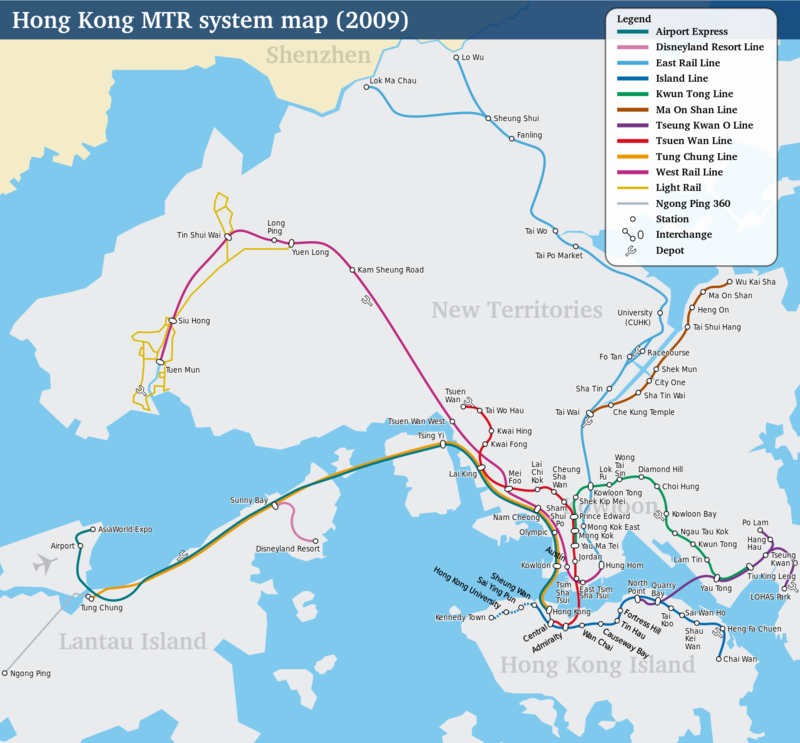The Hong Kong Metro is a subway transportation system that travels throughout the city of Hong Kong, which is a special administrative region of China. Inaugurated in 1979, this system is known as the Mass Transit Railway (MTR). The total length is 218.2 kilometers (135.6 miles). There are 11 operating lines, along with an additional 12 light rail routes. 93 of the system’s 159 stations make up the metro while the other 68 are a part of the light rail.
In addition to service within the city, this system includes long distance trains, as well as the express train to the airport. Since the year 2000, the MTR has been constantly expanding, and it stands as a construction model to other Chinese cities.
System fares vary, depending on the distance traveled. The two-station trip is the most cost efficient, at just 2 Hong Kong dollars, ($US 0.25). The metro schedule ranges from about 6:00 a. m. to 1:00 a. m. the following morning, with some variation.
Metros in China: Hong Kong Mass Transit Railway (MTR)
Since 1997, Hong Kong has constituted a special administrative region of the People’s Republic of China.
China ceded Hong Kong to the British, in 1842, after the First Opium War. It began as a small fishing port, but the passing years watched it transform into a large metropolis with millions of inhabitants. It became a symbol of British imperial power in East Asia.
The British government lost control as a result of Japan’s invasion at the beginning of the Second World War. British authority was ceded to the Republic of China, beginning in 1997, marking the politics of one state, two systems. Outside of diplomacy and defense matters, Hong Kong maintained a capitalistic system that cemented the government’s hybrid regime to its vast self-governing power.
Hong Kong is a financial investment destination. The city is also well regarded for its grand skyscrapers. There is a high human development index and its residents enjoy a long life expectancy. The official languages are Chinese Cantonese and English. Due to its proximity to the Tropic of Cancer, the city usually remains slightly warm. The temperature ranges between 18 and 20 °C (64.4 and 68 °F), during the cold months and during the warm months, temperatures range between 26 and 29 °C (78.8 and 84.2 °F).
The Metro
The Hong Kong Metro, also known as the Mass Transit Railway (MTR) is 218.2 kilometers (135.6 miles) grouped along 11 lines. 93 of the system’s 159 stations make up the metro while the other 68 are a part of the light rail.
The system covers the region’s three large zones, including Hong Kong island, Kowloon and the New Territories.
 Hong Kong Metro, MTR
Hong Kong Metro, MTR
At least eight models demonstrate the system’s large variation in rolling stock. M is the primary one, manufactured by the British company, Metro Cammell. Model A is manufactured by Adtranz and CAF. A consortium of Hyundai and Mitsubishi manufacture the K models. The C series is by the Chinese manufacturer CRRC Changchun Railway Vehicles. The MLR has been a replacement for the Hyundai R series since 2018 and like the M series, it is manufactured by Metro Cammell. Both Kinki Sharyo and Kawasaki manufacture the SP1900 EMU model, which began operating in 2001. Lastly, is one of the most modern models, known as the EWL C train. Manufactured by CRCC Changchun Railway Vehicles, it began operating in 2017.
Daily ridership is approximately 5,200,000 passengers. The system is operated by MTR Corporation Limited, a varied company that has expanded its domain to transportation related services in other Chinese cities and throughout the world.
- Known as: Mass Transit Railway (MTR)
- Length: 218.2 kilometers (135.6 miles)
- Rail width: 1435 mm (56.50 in) including the East Rail lines, West Rail, Ma On Shan and the light rail. 1,432 mm (56.38 in) on the remaining lines.
- Number of lines: 11 metro, 12 light rail
- Number of stations: 159: 93 metro and 68 light rail
- Web site: www.mtr.com.hk
- Operator: MTR Corporation Limited
- Daily ridership: 5,200,000 passengers
- Founded: October 1, 1979
Brief history
In just a few decades, Hong Kong’s small British fishing port was transformed into a grand metropolis. Consequently, the government began to develop studies and plans to address its transportation issues. A 1966 study indicated that the population would grow to almost 7 million by 1986. Developing a transportation system that could meet various traveling needs, over the long term, was a necessity.
The initial construction process of a 20-kilometer (12.4 -mile) system began, in 1970, after several changes to the original plan. Following some concession disputes, construction of the system resumed in 1975.
The northern portion was inaugurated on October 1, 1979, beginning the system’s initial phase. It quickly grew to reach what is currently Central station, while the number of passengers simultaneously increased along with the number of train cars.
Construction work began on the Tsuen Wan line in 1978, and signs of progress begin to take shape, with its inauguration in 1982.
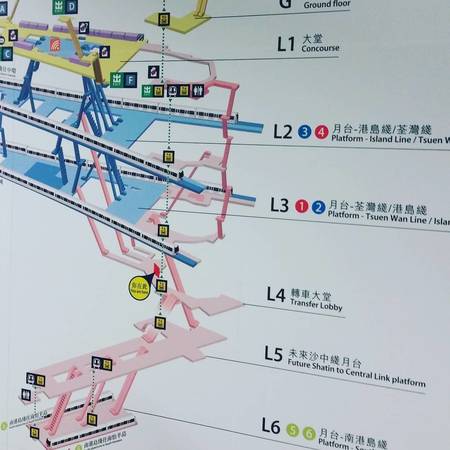 Hong Kong
Hong Kong
Construction on the third line began in 1980, followed by its inauguration in 1985. More expansions followed, including the impressive construction of the Airport Express line and metro access to the Disneyland Resort.
MTR began a privatization process in 2000 that accelerated the inauguration of the newest line in December 2016. This completed the coverage of Hong Kong’s 18 districts.
Lines and stations
The Hong Kong Metro (MTR) system is very extensive. Including the light rail, it is completely operated by the MTR company. The lines include:
East Rail
This is Hong Kong’s oldest railway line. It was founded, in 1910, as one of Kowloon-Canton Railway’s three lines. With the construction of the Hong Kong Metro, it was expanded and electrified between 1982 and 1983 and incorporated into the urban transportation system.
The current length is 42 kilometers (26 miles) and there is a total of 14 stations. It is the system’s longest line and Hung Hom, traditionally known as Kowloon, is its terminal station.
East Rail’s route runs north throughout the area to Sheng Shui station, where it branches off in two directions. It travels west to Lok Ma Chau, connecting to the Futian Checkpoint Station on the Shenzhen Metro and it runs east to Lo Wu, connecting to Lohou, also on the Shenzhen Metro. Cyan is this line’s distinctive color.
Kwun Tong
Located entirely in the Kowloon zone, the Kwun Tong station was inaugurated on October 1, 1979. This was Hong Kong Metro’s first line and its current 17 stations give it a total length of 13.8 kilometers (8.6 miles). The route consists of an inverted U-like shape that runs across the Victoria Harbor. Tiu Keng Leng and Whampoa are the terminal stations and green is its distinguishing color.
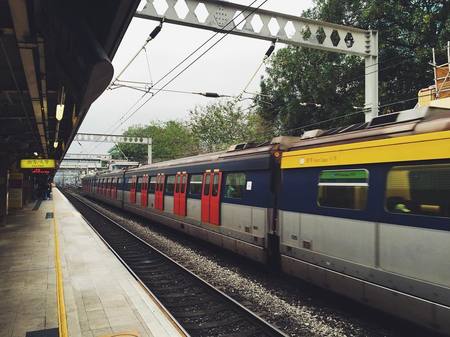
Tsuen Wan
Inaugurated on May 17, 1982, Tsuen Wan was MTR’s second line. Distinguishable by the color red, there are 16 stations and the route extends 16 kilometers (9.9 miles). This line travels along the north-south corridor from Hong Kong Island to the New Territories. Its terminal stations are Tsuen Wan in the far north and Central station in the south, with Central station being the system’s most important stop.
Island
The southern part of Hong Kong, known as Hong Kong Island, is the part of the region that was once colonized. Island line is the only one that crosses through the area from east to west and in regard to easing traffic, this line has become an essential part of the system. There are 17 stations along 16.3 kilometers (10.1 miles). The terminal stations are Kennedy Town, in the far west and Chai Wan in the east. The renowned Central station can be found on this line and medium blue is the Island line’s distinguishing color.
Tung Chung
Tung Chung line has been in operation since June 21, 1998. It is one of the system’s major pathways, connecting to various islands. Its 31.1 kilometers (19.3 miles) make it the fourth longest line in the system, although it has just eight stations. Tung Chung station is the most western point on Lantau Island, passing through the residential island of Tsing Yi. From here, it travels on the surface level and around the entire coast of Kowloon until it returns to cross the sea and arrive at the Hong Kong terminal station, on Hong Kong Island. Orange is this line’s distinguishing color.
Airport Express
The Airport Express route runs almost completely parallel to the Tung Chung line. It is 35.3 kilometers (21.4 miles) and has just five stations. It is the third longest line but, just like the South Island line, it has the second least number of stations. The Airport Express originates in the west from Chek Lap Kok Island, at the AsiaWorld-Expo station. From there, it travels to the Airport station, which services the airport from the city. It then reaches Lantau Island, where it begins to run parallel with the Tung Chung line. This line also ends at Hong Kong station on Hong Kong Island. Its distinguishing color is bluish green.
Tseung Kwan O
The system’s purple line, known as Tseung Kwan O, was inaugurated on August 4, 2002. This is the most eastern location on the Hong Kong Metro. It departs from North Point station, on Hong Kong Island. The train travels along the surface level to Quarry Bay. At Tseung Kwan O station, it branches off to Po Lam terminal station in the north and to LOHAS Park station in the south. There are eight stations along 12.3 kilometers (7.6 miles).
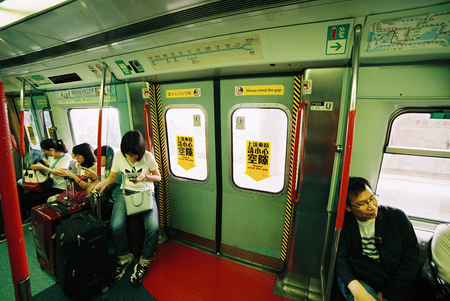
West Rail
West Rail is MTR’s second longest line. It is 35.4 kilometers (22 miles) and includes 12 stations. Inaugurated in 2003, this line runs along the southeast-northwest corridor, departing from Kowloon station and crossing the New Territories. The terminal station in the south is Hung Hom while the terminal station in the north is Tuen Mun. The line’s distinguishing color is light purple.
Ma On Shan
Inaugurated on December 21, 2004, Ma On Shan is found entirely within the Shin Tin district and is one of the system’s most isolated eastern stations. The northern terminal station is Wu Kai Shai while Tai Wai is located the far south. Tai Wai serves as a connection to the East Rail, making it the one transfer point to the rest of the system. There are nine stations, covering 11.4 kilometers (7.1 miles) and brown is the line’s distinguishing color on station maps.
Disneyland Resort
China is a country, now also subject to Disney’s influence. The Hong Kong Disneyland Resort was opened in 2005, becoming the second of its kind in Asia. The metro’s Disneyland Resort line was opened that same year, on the first day of August. With just two stations, covering 3.8 kilometers (2.4 miles), this is the system’s shortest line. The distinguishing color is pink and it connects to the rest of the system at Sunnt Bay station on the Tung Chung line, on Lantau Island. The other terminal station is named Disneyland.
South Island
This is the most recent line on the Hong Kong Metro. Identified by the color lime or apple-green, it is located entirely on Hong Kong Island. There are 5 stations along its 7.4 kilometers (4.6 miles). It departs from the north of the island at Admiralty station and connects to the Tsuen Wan and Island lines. The terminal station in the south is South Horizons.
Light Rail
The light rail is another important part of the system. There is a total of twelve trolleybus-like lines, all concentrated in the New Territories, in the districts of Tuen Mung and Yueng Long. All 12 lines connect to a station on the West Rail metro line.
- 505: 505 runs from Sam Shing to Siu Hong, where it connects to the metro. Red is the distinguishing color.
- 507: This line is identified by the color green and runs from Tuen Mun Ferry Pier to Tin King. It connects to the metro at Tuen Mun stop.
- 610: This line is identified by the color brown and also departs from Tuen Mun Ferry Pier. It runs to Yueng Long, which also serves as a transfer point to the metro.
- 614: Like line 610, this line also runs from Tuen Mun Ferry Pier to Yeung Long. However, it has its own distinctive route and is designated by the color cyan.
- 614P: 614P is distinguished by the color pink. It runs from Tuen Mun Ferry Pier to Siu Hong, where it connects to the metro.
- 615: This is another line that departs from Tuen Mun Ferry Pier. The final stop is Yeung Long but it covers more stations.
- 615P: This line is distinguished by the color, dark blue, although it also covers the route from Tuen Mun Ferry Pier to Siu Hong.
- 705: 705 is a circular line, distinguished by the color, light green. It begins and ends at Tin Shui Wai stop, which connects to the metro.
- 706: 706 follows the same route as 705 but covers it in a counter clockwise direction. Its distinguishing color is lilac.
- 751: 751 is designated orange on station maps. It runs from Yau Oi to Tin Yat and the Tuen Mung, Siu Hong and Tin Shui stops connect to the metro.
- 751P: 751P departs from Tin Shui Wai and ends at Tin Yat. This route does not run during peak hours nor on school and public holidays. Black is the distinguishing color.
- 761P : 761P is another line, with a distinctive route connecting it from Tin Yat to Yuen Long stop. It is distinguished by the color purple.
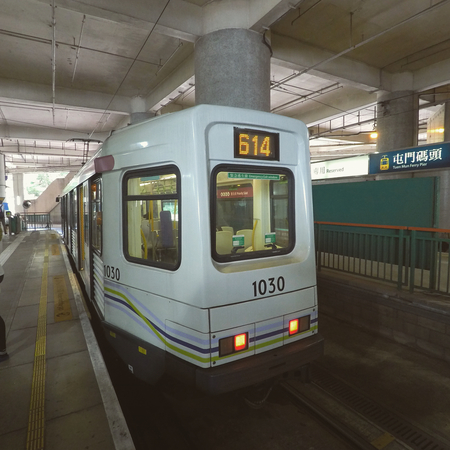 Big Wave Bay
Big Wave Bay
Connections to other systems
Hong Kong is a large city, but a strong connection to China failed to develop, due to its many years as a British colony. Now that it is a special administrative region of China, it has been unified through the various existing transportations systems. Additionally, the MTR’s adaption of several railway lines to the system has helped by connecting all the compass points.
Primarily, there are the long-distance trains. They are only available at Hung Hom station and run to Peking, Shanghái and Cantón. Since trips between Hong Kong and the rest of China are considered international, necessary documentation must be presented, to access these trains. The other major connection to the rest of China is at the end of the East Rail line, where the terminal stations connect to the Shenzhen Metro.
Hong Kong’s geography is rather irregular. One of the city’s most notable transportation systems is the Central-Mid Levels escalator and walkway. This is the longest outdoor covered escalator system in the world. The system is free of charge and located very close to Central Station.
The city’s trams are also very important. They are largely traditional and have been in operation since 1904. There are six lines and 120 stations, all located on Hong Kong Island. The Hong Kong Tramways is the only system in the world to operate entirely with double decker trams. Its connection with the metro is available at Admiralty and other stations in this zone.
Hong Kong also has funicular railways that travel over mountainous areas. The most famous is Peak Tram. Inaugurated in 1888, it transports tourists to the highest levels on Hong Kong Island. This railway also runs to Mid Levels; the academic, residential and natural epicenter of the city.
Ocean Express is another funicular railway. Belonging to the Ocean Park Hong Kong marine park, it connects to the new South Island line. Additional funicular railways include the Po Fook Hill Elevator and the Discovery Bay Elevator
There is also a small cable car system, located on Lantau Island and known as the Ngong Ping 360.This system is integrated with the metro and the only one also operated by MTR. The cable car connects to Tung Chung on the line by the same name within the tourist populated city of Ngong Ping. The tourist city also serves as the headquarters of a Buddhist monastery.
In 2016, there were five companies operating the city buses. The Kowloon Motor Bus (KMB) is the most significant. It makes up 67% of the fleet followed by the Citybus Limited which makes up 16 % and the New World First Bus which makes up 13 %. The Long Win Bus Company Limited and the New Lantao Bus Company are two more. KMB has more than 3900 buses on 400 routes while the Citybus has more so expanded to the inner city. The public light buses offer an additional mode of city transportation. These microbuses provide service to the urban routes and hold a capacity of 16 -19 people.
Another important transportation mode for the city is the ferry. As a maritime port, the connection between islands and beyond the borders are usually completed by boat. Nine companies operate the internal routes. Star Ferry, New World First Ferry, Hong Kong & Kowloon First Ferry, Chuen Kee Ferry, HKR International Limited, Park Island Transport Company Ltd., Fortune Ferry, Coral Sea Ferry and Tsui Wah Ferry. Additional routes run outside the city. They travel to Macao, departing from Hong Kon-Macau Ferry Terminal, located next to the Island Line’s Sheung Wan station. The rest of China’s southeastern cities connect at Hong Kong China Ferry Terminal and Skypier, the terminal integrated with the airport.
 Hong Kong International Airport Connection
Hong Kong International Airport Connection
Connections to the airport
The Hong Kong Metro system is completely integrated with the Hong Kong International Airport. This airport is located on Chep Lak Kok Island and is built almost entirely of land reclaimed from the sea. The airport is commonly known as Chep Lak Airport, distinguishing it from its predecessor, Kai Tak. According to the number of passengers, this airport has the world’s largest volume. However, it is the world’s eighth busiest airport.
The Airport Express Line provides access to the Airport Station in both terminals 1 and 2. A transfer can be made from the Tung Chung Line to the Airport Express Line from Tsing Yi, Kowloon and Hong Kong stations. A pedestrian transfer can be made from Hong Kong to Central station, which is part of the Island and Tsuen Wan lines.
Schedule and frequency
The Hong Kong metro schedules vary according to each line. Opening time ranges between 5:30 and 6:15 a.m. while closing is usually between 12:30 and 1:15 a. m. The frequency varies on weekdays, Sundays and holidays (which share the same hours) and Saturdays. The metro includes the following schedule.
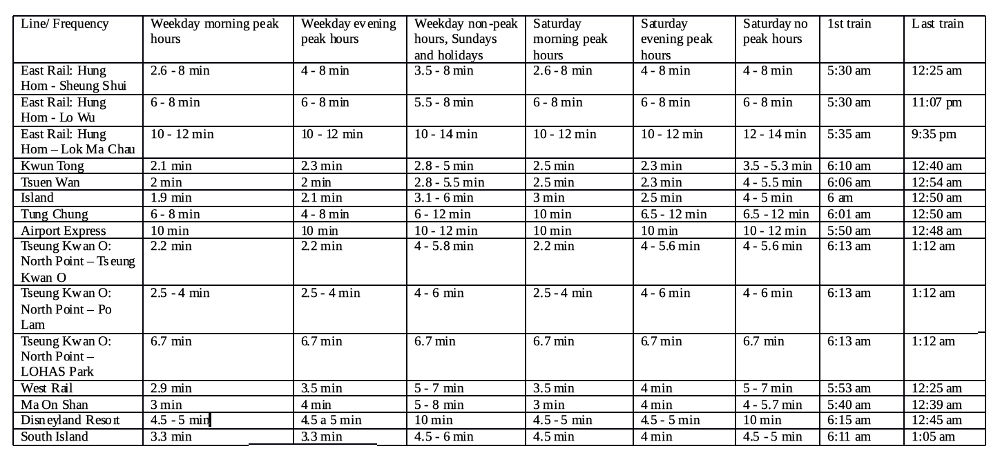 Hong Kong MTR: Schedule and frequency
Hong Kong MTR: Schedule and frequency
Fees, tickets and cards
The Hong Kong Metro has multiple payment options. Riders can choose between individual tickets, with a designated number of trips or a contactless Octopus card. There are two types of one-trip tickets: adult tickets and concessionary ones, which are available to children between 3 and 11 and seniors over 65.
Another popular option is the Octopus card. This electronic card has facilitated riders’ access to the metro since 1997.
Advanced trip planning is recommended as prices vary greatly and purchases can be made at metro stations, with the knowledge of which tickets are required. The price depends on the distance traveled. The following table offers a reference from the minimum to maximum value, according to the final station destination of the line.
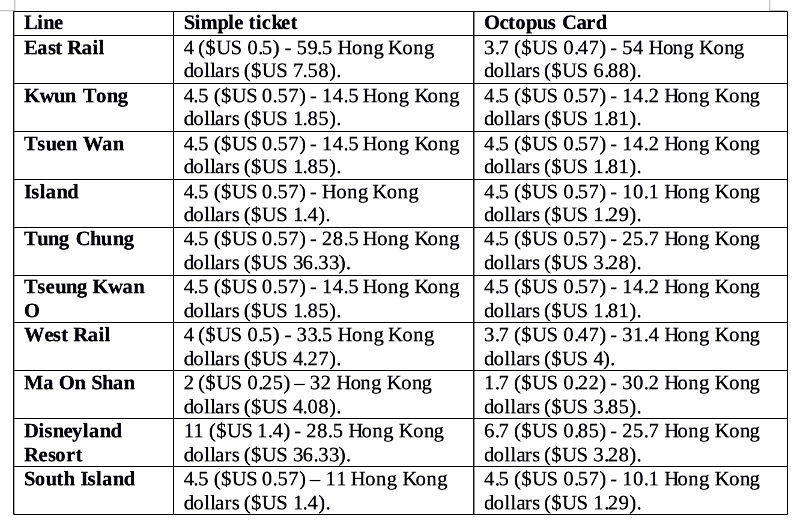 Hong Kong MTR Fees
Hong Kong MTR Fees
The payment system for the Airport Express line is unlike the others. Costs include:
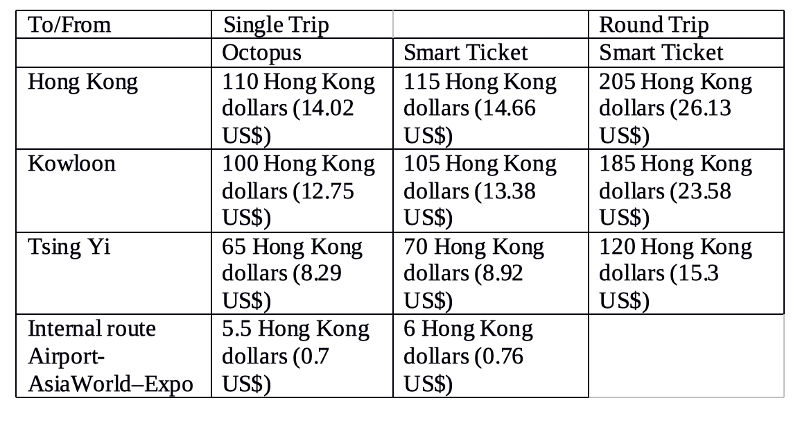 Hong Kong MTR Airport Express Line fees
Hong Kong MTR Airport Express Line fees
The MTR provides a first-class compartment for its riders. This last car is guaranteed to offer much more space and comfort and it is arranged in a way to carry fewer standing passengers. The price is considerably higher than standard fares and the fine for being in first class without a valid ticket can reach up to HK$ 500 (US$ 63.73).
Lastly, is the tourist ticket. An adult ticket costs HK$ 65 ($US 8.29), while a child ticket costs HK$ 30 ($US 3.82). This ticket covers an unlimited number of trips during a day in MTR’s system, no matter the trip type, including the light rail. The Airport Express lines, first class service and trips to and from Lo Wu and Lok Ma Chau terminal stations on the East Rail line are not included.
Future expansions
In addition to planned expansions, there are many already underway. One of the main plans includes construction of the South Island West line, which will connect the existing South Island line with the western part of the Island line, in a semicircle. Likewise, there is a project from the Sha Tin corridor to Central Link, which will connect Tai Wai and Hung Hom stations on the Ma On Shan line. An additional plan is the extension of Hung Hom to Admiralty via the East Rail.
The North Island line, in the northern section of Hong Kong Island, in addition to the Northern Link is another proposal. The Northern Link will connect the West Line’s Kam Sheung Road station to the East Rail’s Lok Ma Chau station, facilitating the connection to Shenzen Metro. The construction of the East Kowloon line, joining the eastern part of this section, is also proposed.
Tips
It is important to follow certain tips on all metros, especially when traveling as a tourist in a foreign country. Some tips to go along with your trip include:
- Plan your trip ahead to determine the ticket price.
- Make sure you have a basic understanding of at least one of Hong Kong’s two official languages: English or Cantonese (though signs are also in Mandarin).
- When crossing from Hong Kong’s borders to the rest of China, it is important to familiarize yourself with the necessary immigration requirements.
- Avoid mistakenly boarding the first-class car, if you did not previously purchase a first-class ticket.
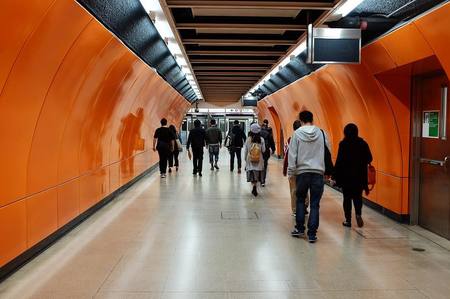
Notable facts
- This is one of few systems in the world to have a first-class metro car.
- Artwork, made in the framework of operator-inspired programs, can be found in the stations.
- The Hong Kong Metro has various rail widths.
- Part of the system was constructed from the old railway lines.
- With recent expansions, the system now covers 18 city districts.
Sightseeing via Hong Kong Metro
Hong Kong’s history as a British colony, its vigorous economic power, the skyscrapers and the significance of its port make it a major destination for millions of tourists. The city grows more welcoming to visitors as it presents a multitude of opportunities for trade and sales, as well as peaceful green and marine spaces. Coupled with all this are the theme parks, found to be extremely inviting to tourists. Some sites to visit using the Hong Kong Metro include:
Hong Kong Park : Opened in 1991, this modern park is 80,000 square meters (861,113 square feet). There are a variety of places to visit here, including the Flagstaff House Museum of Tea Ware, as well as the buildings of former British colonial institutions. The esteemed Edward Youde Aviary is also in the interior. To reach the park, one need just walk 200 meters (a few minutes) from South Island Line’s Admiralty Station.
Hong Kong Disneyland : This is Disney Park’s fifth resort, worldwide. Located within the Hong Kong Disneyland Resort complex, it is divided into four large areas: Main Street, USA, Adventureland, Fantasyland and Tomorrowland. It welcomes millions of visitors each year and is currently undergoing an expansion. A metro line especially designated for this park makes it easy to reach. From Disneyland Resort line, one can simply get off at Disneyland station.
Kowloon Park : This is a large park located in Kowloon’s Tsim Sha Tsui zone. It is 13.3 hectares (32.9 acres) and was formerly Whitfield Barracks, the barracks of the British army stationed at the port. It is now the site of the Hong Kong Museum of History and the Hong Kong Heritage Discovery Centre, as well as an aviary and a pool. The park is accessible from Tsim Sha Tsui station on the Tsuen Wan line. It is also accessible from Jordan station on the Tsuen Wan line and Austin station on the West Rail line, although these stations are a little farther away.
Ngong Ping : This is a small highland located in the western part of Lantau Island. Situated among mountains, it houses the eminent Po Lin Buddhist monastery, founded in 1906. Also found here is the renowned bronze Buddhist sculpture, the Tian Tan Buddha. It was unveiled in 1993 and measures 34 meters (111.5 feet). To reach this site, one must take the Ngong Ping 360 cable car from Tung Chung station (on the Tung Chung line).
Hong Kong MTR map
- Also Known As: MTR
- Passengers/Day 3620000
- Fares: 0.91
- 24h operation: No
- Air Conditioning: Yes
- Walk between platforms: Yes
- Driverless trains: Disneyland Resort Line (since 2005)
- Screen Doors Platforms: All underground stations
- Operator: MTR Corporation
- HK$65
- Hong Kong Metro Official Website
- Tlf: 2881 8888
Help us
If you consider that the information we provide is wrong, not accurated, outdated, translation contains errors, and you would like to help us to improve the file...you can contact us here.
Feel free to contact us if you dont find the system you're looking for and we'll add it as soon as we can!
Thank you very much!







